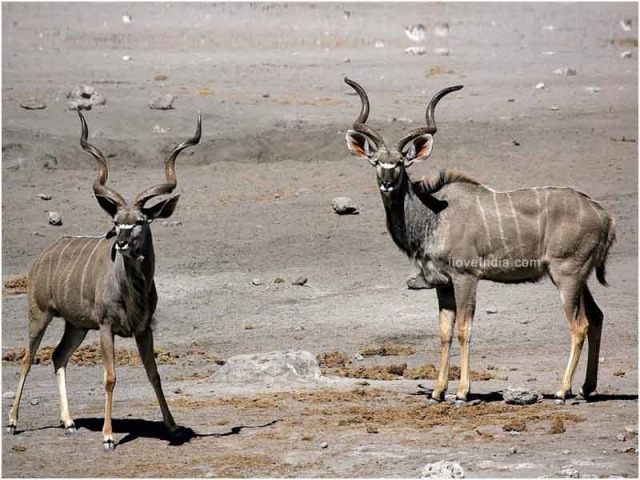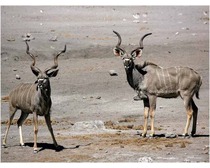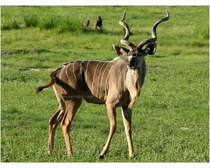Kudus are a variation of antelopes. Check out the interesting and amazing information on Kudu given below.
Facts About Kudu
Kudus are a variation of the antelopes residing in dense bush or forest areas. There are two subspecies existing worldwide: the Lesser Kudu (Tragelaphus imberbis) and the Greater Kudu (Tragelaphus strepsiceros). Both of them have stripes or spots over their body with a chevron of white hair just between their eyes on the forehead. Males as well as the females have long spiral horns which can grow up to a maximum of 72 inches comprising of two and a half graceful twists and coils. It is these horns that make these animals very prone to human attack. These gracefully twisted horns are used as musical instruments in many parts of Africa and are also sometimes used as honey containers and also as a symbol of male potency. To know more about these amazing creatures, go through the information provide by us in this article.

Kudu Facts
Kingdom: Animalia
Phylum: Chordata
Subphylum: Vertebrata
Class: Mammalia
Order: Artiodactyla
Family: Bovidae
Genus: Tragelaphus
Species: T. strepsiceros
Size: Approximately 1.2 to 1.5 m (4 to 5 ft)
Weight: Male: 225 to 357.7 kg (495 to 787 lb); Female: 180 to 235 kg (396 to 517 lb)
Life Span: Approximately 15 years in the wild
Diet: Mainly grass, roots, leaves, fruits and tubers
Range: Southern and Eastern Africa to as far north as Ethiopia
Habitat: Stony, sparsely to densely forested flat hilly and mountain country
Age of Sexual Maturity: 1 to 2 years
Gestation Period: Approximately 6 to 7 months
Number of Offspring: one (rarely two)
Interesting And Amazing Information On Kudus:
- Kudus are one of the largest varieties of antelopes.
- They are mainly woodland animals and suffer from habitat destruction. Also, they are an important source of food for predators like lions and spotted hyenas.
- Kudus are also hunted for their horns which are regarded as valuable trophies. Apart for their horns, they are hunted for their meat in some places and also because they are considered as pests for occasional crop damage.
- The horn of this animal is used as a musical instrument in some places. In certain Jewish ceremonies, another form of this horn is used as a shofar. The horn is also used in Scouting movement’s Wood Badge training program to signal the start of a training course or activity.
- Kudu horns are spiral in shape and allow the males to spar by interlocking them. The males then continue with their tryst by shoving and twisting each other until one of the opponents is knocked off balance and thrown down. There are even reports of such trysts ending in deaths.
- Kudus make a peculiar gruff like barking sound which is considered as one of the loudest sounds made by antelope.
- The markings and cryptic coloring on their skin protect the kudus by camouflaging them. If they are alarmed, they stand very still and this makes it very difficult to spot them.
- Although these animals are very home-bound and limit their movements to a small home range, they are known to wander more widely in search of food during the dry season.
Female kudus and their young ones are joined by the males only during the mating season. Otherwise, they limit themselves to small groups of six or eight members. - At the time of birth, the pregnant females move out of their groups leaving the newborn to lie for around 4 to 5 weeks. Gradually, the calf starts to accompany its mother for short periods and by 3 or 4 months stays with her all the time.


See also
More from iloveindia.com
- Home Remedies | Ayurveda | Vastu | Yoga | Feng Shui | Tattoos | Fitness | Garden | Nutrition | Parenting | Bikes | Cars | Baby Care | Indian Weddings | Festivals | Party ideas | Horoscope 2015 | Pets | Finance | Figures of Speech | Hotels in India : Delhi | Hyderabad | Chennai | Mumbai | Kolkata | Bangalore | Ahmedabad | Jaipur
- Contact Us Careers Disclaimer Privacy Policy Advertise With Us Lifestyle Sitemap Copyright iloveindia.com. All Rights Reserved.




